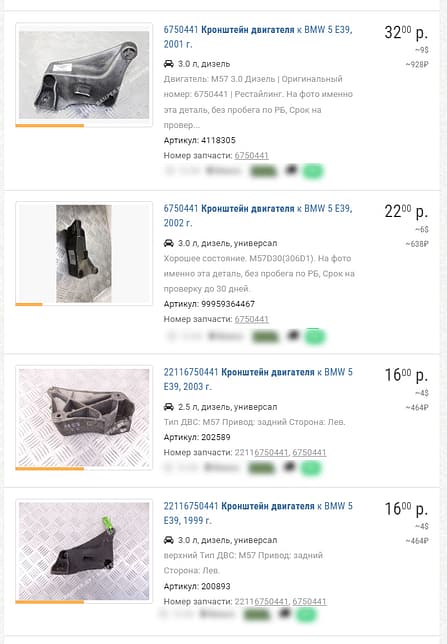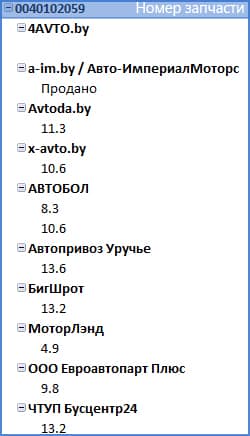Price analysis is a comprehensive process of collecting, monitoring, processing and subsequent analysis of competitors' prices for auto parts. Price analysis also allows you to identify the pricing strategies of competing companies, and most importantly, determine your optimal pricing strategy to increase profits.
Let's consider the mechanism for analysing the prices of automobile spare parts using a real example. ShopService.pro has a ready-made successful case for this.
Who benefits most from price analysis?
Primarily, e-commerce entities specializing in the resale of used auto parts, boasting an inventory exceeding 15,000 car components. A primary avenue for sales entails a prominent platform tailored for advertising both new and pre-owned auto parts, akin to a marketplace exclusively tailored for automotive goods.
Who else can use price analysis?
- This invaluable tool extends its utility to vendors peddling both new and pre-owned auto parts on specialized online platforms.
- The above method may also be of interest to anyone from the retail sector of used and new goods trading on marketplaces.
- The tools described in this case study are applicable in many areas of retail, so this material will be of interest to everyone who is somehow connected with e-commerce.
Client Challenges

Amidst an extensive array of spare parts, our client grappled with pricing ambiguity. The vast spectrum of prices on the marketplace made determining the optimal cost for each part a formidable undertaking.
Adopting a simplistic approach like Cost-plus pricing, wherein a desired margin is added to total expenses (procurement, logistics, advertising, payroll, taxes, etc.), risked forsaking potential gains or alienating clientele.
Thus, the crux of price analysis lies in discerning the most fitting pricing strategy for auto parts. This entails unravelling competitors' pricing methodologies to ascertain the most effective ones.

Example for a better understanding of the task
Consider a specific spare part, identified by article number 6750441.
Evidently, the price disparity is substantial, with costs fluctuating twofold!
In this case, if you set the price of a part too high, you may lose the customer; if you set the price at a low level, you may miss out on additional profit.
Each advertisement for the sale of spare parts contains additional parameters that affect the final cost.
What difficulties arise in solving the client’s problem?

- There are more than 12 million positions on the platform for posting advertisements for the sale of auto parts. Collecting such a volume of data will take a very long time. Therefore, it is necessary to reduce the list of analysed products at the initial stage. For effective data analysis and correct comparison of the client's product items with competitors' products, additional data is required from the customer.
- It should be taken into account that the cost of a spare part may vary depending on its condition and year of manufacture. Therefore, it is also necessary to collect a description of the part and comments on it, where the condition of the product will be indicated.
- Also, the price of a part may depend on availability in the warehouse or delivery to order, as well as on the possibility and cost of delivery. Therefore, it is desirable to have this data. This can be useful for identifying competitive advantages.
- To identify sellers, it is necessary to collect all data relating to them. Therefore, you need to collect additional information about sellers: Name, Address, ID, Reviews, Delivery conditions, rating, provision of instalment plans or credit, etc.
- It is also advisable to know the price history and sales statistics of all market participants in order to know which sellers sell their goods with great success: those who set the lowest prices on the market or those who sell at a higher price , but at the same time provide additional services, or those those who stick to the average price. There are other examples of market behaviour. Therefore, based on the data obtained, it is necessary to determine the main pricing strategies of competitors and highlight the most effective ones.
- To monitor the activity of sellers, the effectiveness of ads, the history of price changes, you will need information about each posted ad: cost of the product, date of placement, date of update, ID and URL of the ad.
- One spare part may fit several models. Therefore, you need to collect additional information on the spare part, for example, which car the part is from, as well as the original number or article number of the spare part. This may be useful in the future for structuring the obtained data.
Solving customer problems

At the initial stage of analysis, the client was asked for a list of required items for analysis. We also asked for as much information as possible on the products. After all, the more input information, the easier and better quality the final report is. For this, separate data on product categories, original numbers, articles, SKUs, etc. could be useful.
The customer was able to provide an Excel file with about 15,000 items. However, it contained information only with the name of the spare parts and their price.
It’s good that most (about 70%) of the names contained a spare part number, so we were able to isolate this number from the name. It will be useful to us for a more accurate comparison of products.
It should be noted that this quantity is quite enough to determine the optimal pricing strategy, because the final list of products for analysis remains quite large.

There are often situations when customers do not provide identification parameters of products at all, for example, such as ID, SKU, brand, weight, article (for example, simply “Toilet soap”). Or the names of items include identification data, but there is no system or pattern in the construction of names. In such cases, we use other matching algorithms, but they may differ in their accuracy.
In this case, the spare part number was at the very beginning or end of the product name, or was designated “no.”, “number”, “sku”. This made it possible to highlight the spare part number for more accurate identification.
Next, a program was developed to gather data from the presented site. The search for the required products on the site/marketplace was carried out using a unique spare part number.
The robot imitated the behaviour of a regular website visitor so as not to burden the source site. Thus, the necessary data was collected at the same speed as if an ordinary person viewed each page for 1-3 seconds.
We also note that all collected data is publicly available. No laws or copyrights were violated. In the same way, data is collected by search robots Google, Yandex, Bing and many other systems.
The data collection process occurred weekly over a span of three months, a frequency tailored to the client's preferences, although other intervals, such as daily, could be equally viable. This periodicity facilitated diligent monitoring of competitors' pricing dynamics, enabling the identification of price fluctuations and sales occurrences. By discerning these patterns, one can glean insights into competitors' behavioural strategies, discerning the efficacy of each approach and ultimately crafting an optimal pricing strategy. Notably, the ability to customize pricing strategies for each product category adds a layer of adaptability crucial for navigating the market's nuances.
What specific data was gathered?
The dataset comprised various elements: product names, prices, article and spare part numbers, product photos, categorizations, unique identifiers, URLs, placement and update dates of advertisements, payment options, spare part descriptions with comments, condition (new or used), vehicle make and year of manufacture, seller details, and supplementary information provided by the seller.
What kind of data processing has been done?

To streamline the data processing endeavour, certain exclusions were made. Defective or substandard parts were omitted from analysis to preserve data integrity.
Additionally, at the client's request, certain categories, like engines, required manual evaluation due to their nuanced condition assessments.
Then there was a matching of products that are available at the customer's place of business and the products presented on the marketplace.
Upon collating the customer's inventory with the site's offerings, various data presentation formats were generated for the client's convenience.
Final result
The culmination of this endeavour resulted in a comprehensive report encompassing over 23,000 spare parts. This report furnished detailed insights, including
part numbers, names, article numbers, car models, sellers, pricing trends, ad alteration dates, and descriptive comments.

Additionally, a supplementary report specifically scrutinized spare parts sold during a designated timeframe.
This data empowers effective analysis and continuous monitoring of competitors' pricing strategies. By gathering prices for a wide array of goods from various competitors, one can discern their pricing tactics. Through consistent monitoring, the efficacy of these strategies becomes apparent, especially by tracking ad closures indicating spare part sales. Furthermore, tracking changes in product cost pre-sale, ad duration, and engagement metrics provides valuable insights.
Resultantly, the client's inventory underwent thorough evaluation, categorizing spare parts and applying bespoke pricing formulas. Separate pricing has also been implemented for parts with defects.
For instance, employing the "Median price minus 5%" formula in one category ensures competitiveness while safeguarding profitability by eliminating extreme pricing outliers.
Thanks to the work done, prices for spare parts were greatly optimized.

This meticulous approach yielded significant price optimization for spare parts, ultimately driving an increase in revenue for the client. By identifying goods with potential for higher pricing without sacrificing sales volume, dormant inventory was successfully reintroduced into circulation.
What additional advice can we offer our client?
- For further enhancement, we recommend leveraging tools to analyse prices from competitors' websites. With many retailers maintaining their own online stores alongside marketplace listings, divergent pricing strategies are commonplace.
- Developing an online store and uploading products can significantly increase sales and profits of company.
- Additionally, conducting a comprehensive marketing analysis of competitorscan unveil key insights into their sales channels, marketing budgets, and promotional tactics. This intelligence can inform strategic decisions to bolster the client's competitive edge.
- Furthermore, conducting a thorough SEO analysis of competitors' websites is paramount. Optimizing the client's website, product listings, and advertisements for search engines can significantly enhance visibility and drive organic traffic, thereby augmenting sales opportunities.




